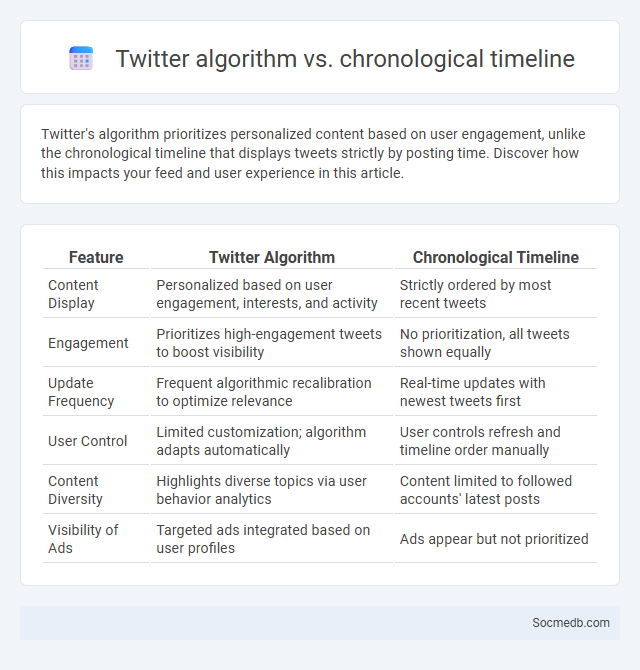
Photo illustration: Twitter algorithm vs chronological timeline
Twitter's algorithm prioritizes personalized content based on user engagement, unlike the chronological timeline that displays tweets strictly by posting time. Discover how this impacts your feed and user experience in this article.
Table of Comparison
| Feature | Twitter Algorithm | Chronological Timeline |
|---|---|---|
| Content Display | Personalized based on user engagement, interests, and activity | Strictly ordered by most recent tweets |
| Engagement | Prioritizes high-engagement tweets to boost visibility | No prioritization, all tweets shown equally |
| Update Frequency | Frequent algorithmic recalibration to optimize relevance | Real-time updates with newest tweets first |
| User Control | Limited customization; algorithm adapts automatically | User controls refresh and timeline order manually |
| Content Diversity | Highlights diverse topics via user behavior analytics | Content limited to followed accounts' latest posts |
| Visibility of Ads | Targeted ads integrated based on user profiles | Ads appear but not prioritized |
Introduction: Understanding Twitter's Content Display Methods
Twitter's content display methods prioritize real-time updates and user engagement by showcasing tweets in a personalized timeline. The platform uses algorithms that curate content based on your interactions, trending topics, and relevance to your interests. Understanding these mechanisms allows you to optimize your visibility and connect with a broader audience effectively.
Overview of Twitter Algorithm: How It Works
Twitter's algorithm prioritizes content based on relevance, recency, and user interactions, using machine learning to personalize timelines. It evaluates tweets through signals like likes, retweets, replies, and user interests to rank posts in Home timelines and Explore tabs. The algorithm also incorporates real-time engagement patterns and trending topics to surface timely and popular content.
What Is the Chronological Timeline on Twitter?
The chronological timeline on Twitter displays tweets in the order they were posted, starting with the most recent. This feature prioritizes real-time updates, allowing users to see the latest tweets from accounts they follow without algorithmic interference. Users can switch between the chronological timeline and the algorithm-driven "Home" timeline for tailored content.
The Trending Algorithm: Surfacing Popular Topics
The Trending Algorithm identifies and surfaces popular topics by analyzing real-time user engagement metrics such as shares, likes, comments, and search frequency. It prioritizes content that resonates with a broad audience, ensuring Your feed stays current with the most relevant and viral discussions. This dynamic system continuously adapts to shifting interests, enhancing Your social media experience by highlighting timely and widely-discussed subjects.
Key Differences: Algorithmic vs Chronological Feeds
Algorithmic feeds prioritize content based on your past interactions, interests, and engagement patterns, ensuring relevant posts appear first to enhance user experience and increase time spent on the platform. Chronological feeds display posts in the exact order they are published, providing a real-time, transparent flow of updates without filtering or ranking, which some users find more authentic and less manipulative. Understanding these key differences helps you customize your social media usage for maximum relevance and control over the content you see.
Pros and Cons of Twitter’s Algorithmic Timeline
Twitter's algorithmic timeline customizes content based on user interactions, increasing engagement by showcasing relevant tweets and trending topics. However, this personalization can create echo chambers, limiting exposure to diverse perspectives and fostering misinformation. The algorithm also prioritizes popular content over chronological order, potentially obscuring real-time updates and smaller voices.
User Experience: Chronological Timeline Benefits and Drawbacks
A chronological timeline on social media enhances your ability to follow conversations and events in real-time, providing an intuitive and straightforward user experience by displaying posts in the order they occur. This format reduces the risk of missing important updates and fosters authentic engagement with fresh content. However, it can lead to information overload and difficulty in discovering older or more relevant posts that get quickly buried.
The Role of the Trending Algorithm in Shaping Conversations
The trending algorithm on social media platforms prioritizes content based on user engagement metrics such as likes, shares, and comments, amplifying topics that rapidly gain traction. This system influences public discourse by spotlighting viral narratives, often dictating which stories dominate user feeds and shape collective conversations. By curating content through algorithmic trends, social media molds perceptions and directs dialogue on a global scale.
Impact on Content Visibility and Engagement
Social media platforms use sophisticated algorithms that prioritize content based on user interactions, significantly affecting your content's visibility and engagement rates. By optimizing posts with relevant keywords, hashtags, and multimedia elements, you can enhance reach and foster stronger audience interaction. Consistent analysis of engagement metrics enables fine-tuning strategies to maximize content performance and audience growth.
Choosing the Best Twitter Timeline Approach for Your Needs
Selecting the best Twitter timeline approach depends on your content goals and audience engagement preferences. Utilizing the algorithmic timeline can enhance exposure by prioritizing relevant tweets based on user behavior, while the chronological timeline offers real-time updates and freshness. Analyzing your target audience's interaction patterns helps determine whether a curated or chronological feed maximizes visibility and impact.
 socmedb.com
socmedb.com